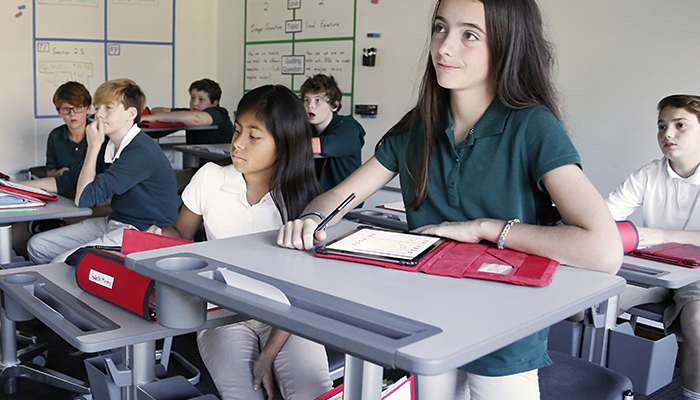Have you noticed? While there is little doubt that classrooms have become more sophisticated and digital, the physical classroom setting and furniture don’t seem to have evolved at the same pace.
It’s true.
The tablets and devices that are transforming the learning process still sit on top of the same style desks from the 1950s. The blackboards and chalk may have been replaced by interactive whiteboards connected to a computer or projector, but far too often, students still sit in stagnant rows looking up in the same direction at the teacher for the daily lesson.
While curriculum modernization creates opportunities for teachers and students to use the classroom space more effectively, traditional classroom furniture does not. In order for the classroom to truly evolve, teachers, principals and district administrators need to address the entire classroom environment.
Consider this about classroom furniture:
- Classroom furniture at the most foundational level should enhance the educational tools and technology it’s supporting. At an aspirational level, it should also support the teachers’ curriculum, the students’ health, comfort and learning styles. This requires a fundamental change in thinking as schools adopt 1:1 technology, requiring analysis of what else is changing in association with the technology.
- Facilitating the move from traditional lectures to more group-based, collaborative and active environments requires adjustable and highly mobile furniture for both students and teachers. Stationary desks do not lend themselves to an active classroom nor do they facilitate a group-dynamic or mobile learning environment that has become so prevalent in today’s educational system.
- A desk that is both height-adjustable and mobile will foster an individualized learning environment that addresses these issues and offers a myriad of benefits to teachers, students and the school.
Why adjustable desks?
Access to adjustable furniture has been proven to help reduce fidgeting distractions, give teachers more time to teach, increase student engagement, improve academic performance and enliven curriculum. In addition, the rising concerns about childhood health issues are addressed when students are given an alternative to sitting all day—introducing standing into the classroom is an effective means to break up sedentary behavior. We’ve seen this played out dozens of times in our LearnFit® ambassador schools across the country.
Input from surveys, interviews and case studies have all demonstrated that teachers prefer desks that facilitate movement and that students adapt to them intuitively. These types of desks foster collaborative learning while satisfying a child’s need for motion and allow for the teacher to use every inch of the environment for instruction.
Given today’s intersection of technology and education, the classroom set-up is at a crossroads. Schools like the Alexandria Country Day School in Virginia get the critical role classroom furniture can play in making today’s classrooms healthier, more collaborative and more conducive to learning even as schools prepare for the next wave of digital instruction.
It is time to “stand up” for important and fundamental changes for today’s classroom and the classroom of the future.



